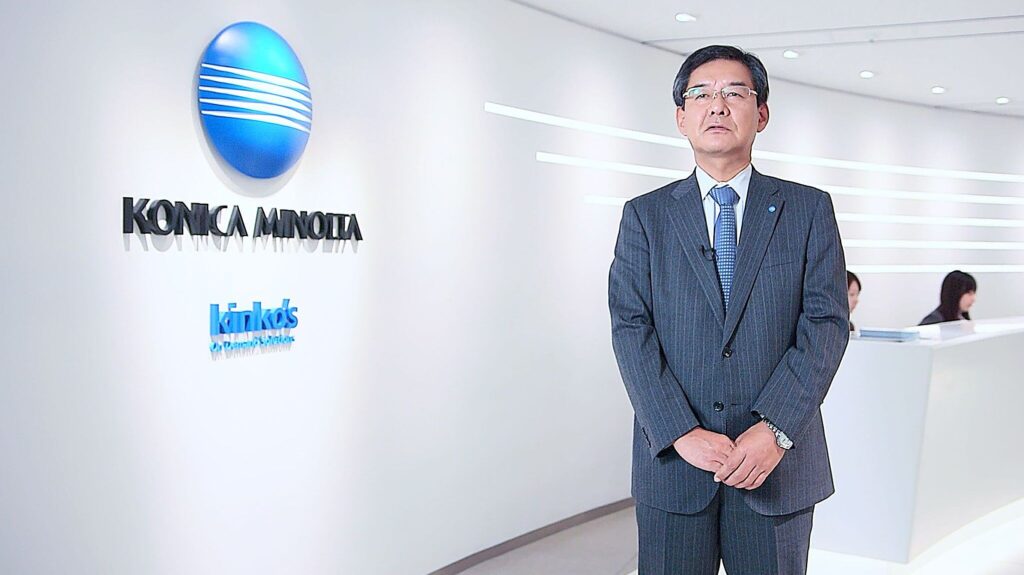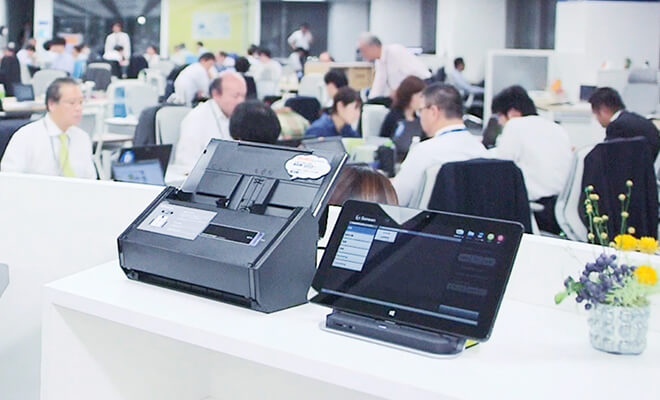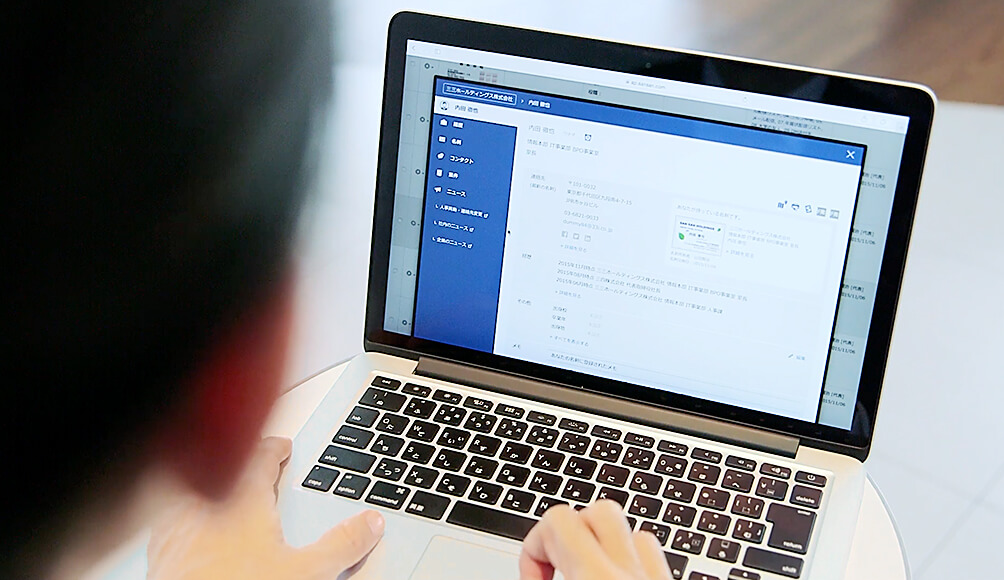Konica Minolta Inc.
- HOME
- Success Stories
- Konica Minolta Inc.
Sansan's follow-up to a trade show resulted in business
negotiations worth several hundred million yen.

Konica Minolta Inc. has been using Sansan since February 2014. As of 2017, they have over 500 Sansan user accounts (mainly in their sales department).
To learn more about the effects of over 500 of their staff sharing business cards with Sansan, we spoke to four members of the Solutions Division: Division Chief Mr. Shino; Deputy Chief Mr. Takahashi; Marketing Chief Mr. Ai; and to Sales Manager Mr. Monma.
Sharing business cards with SE engineers to strengthen solution sales.
[ Interviewees ]
Mr. Shino
Chief, Solutions Division
Mr. Takahashi
Deputy Chief, Solutions Division
Mr. Ai
Marketing Chief, Solutions Division
Mr. Monma
Sales Manager, Solutions Division

Please tell us a little bit about Konica Minolta.
Mr. Shino: Konica Minolta, as a member of the Konica Minolta group, focuses on domestic sales of information-related equipment such as digital multi-function copy machines and printers, and related solutions.
The vision we are pursuing is to be a “Work-Style-Design Company”. Since we sell directly to our customers, we have a thorough understanding of our customer’s challenges. We have an extensive product line-up, and our management principle is “creating new value”. We seek to offer our customers solutions that what we ourselves have actually practised, and inspire our clients by becoming an indispensable partner helping them to success.
How are you using Sansan?
Mr. Takahashi: Around 540 members of our company, including sales people, executives, and also our CEO, are using Sansan regularly.
What made you decide to start using Sansan?
Mr. Takahashi: We started our Solutions Division with the aim to try to sell ‘solutions’; not just to sell ‘things’ such as printers or copiers, but to try to support the entire IT infrastructure of the client. When selling solutions, you are trying to help your clients solve the problems they have, therefore meaning that collaboration with multiple companies is essential. When doing this you need to connect the human networks you have and so, at that time, we realized Sansan could facilitate this.
What kind of problems were you having before you introduced Sansan?
Mr. Takahashi: We had been using a similar business card-based contact management service before. However, we were not satisfied with it due to the accuracy and operation time being below our expectations. Also, the information was never updated and, accordingly, we were not able to share the newest information among our sales team.
Regarding security, we checked thoroughly by asking a number of relevant questions.
What was your first impression of Sansan? What did you notice when you started using it?
Mr. Takahashi: First, we were happy to see that our previous problems of accuracy, expediency and redundancy were gone. Naturally, we wanted to use it but we needed to get the approval of some people within our company. We had to figure out how to make it work with our existing personal information management policy and our basic policy for information security.
What kind of security standards did you need to conform to?
Mr. Takahashi: The fundamental issue was that the information we were scanning in was going to be managed by Sansan, an outside company. To allay our concerns, we asked a lot of very thorough security questions. Sansan were very considerate and professional, and explained everything to us fully.
Together with our responsible department, Sansan checked and adjusted the software in order to meet the world-wide security policy of the Konica Minolta Group.
Making use of the human networks in your company and realizing a new sales style.
How did Sansan change your contact management?
Mr. Takahashi: Until we started using Sansan, we managed our business cards on an individual basis, with each employee handling their own cards. With Sansan, we started managing them as a company. This led to us becoming better able to make use of the human networks within our company and realize a new sales style.
For example, one of our sales reps met a new prospect and scanned the business card into Sansan. Through Sansan, the rep found out that I was acquainted with this prospect and asked me to support him.
This case involved me personally, but I’m sure there are many other cases like this in which vertical or horizontal connections are being shared. You can’t always tangibly see these types of results, but we have had many big improvements in efficiency thanks to using Sansan.
What merits did you find to using Sansan?
Mr. Monma: I am in charge of sales, and if it’s difficult to get an appointment with a prospect, I would check to see if anyone in the company has a connection there, and then make use of that connection.
Our planning department and system engineers also use Sansan, and they have connections that we in the sales department don’t have. These often come in very handy. If we didn’t have Sansan, our approaches to prospects would be considerably slower and less efficient. Now we can quickly check Sansan, and from there send an email or make a phone call directly. This is extremely useful to our sales people.



From a trade show, we found potential business deals that could be worth hundreds of millions of yen.
Do you have any examples of how Sansan helped you with a deal?
Mr. Ai: At a trade show in July 2014, I used Sansan to scan in all the prospects I met, and by following up with people who came to the show, I was able to find 30 potential deals. Many of these became actual orders, totalling hundreds of millions of yen.
How did you use Sansan at the trade show?
Mr. Ai: At the back area of the trade show, we had our Sansan scanner set and we scanned in all the business cards we received there and then. We also collected surveys at the trade show and, by entering these survey results with the business cards, we were able to start following up our prospects from the next day.
By taking this multi-faceted information and processing it according to challenges currently faced and potential challenges, we were able to prioritize the prospects and make our approaches. Due to the fact that we could prioritize them and make our approaches so quickly, I think we were able to realize a lot of potential deals.


We consider the information we have in Sansan as a treasure of our company.
How do you see the future with Sansan.
Mr. Shino: The data we have in Sansan is our company’s treasure. It is a precious resource we will use for our sales in the future. We want to further realize the potential of what Sansan and Konica Minolta can achieve together and continue to create new value in the future.